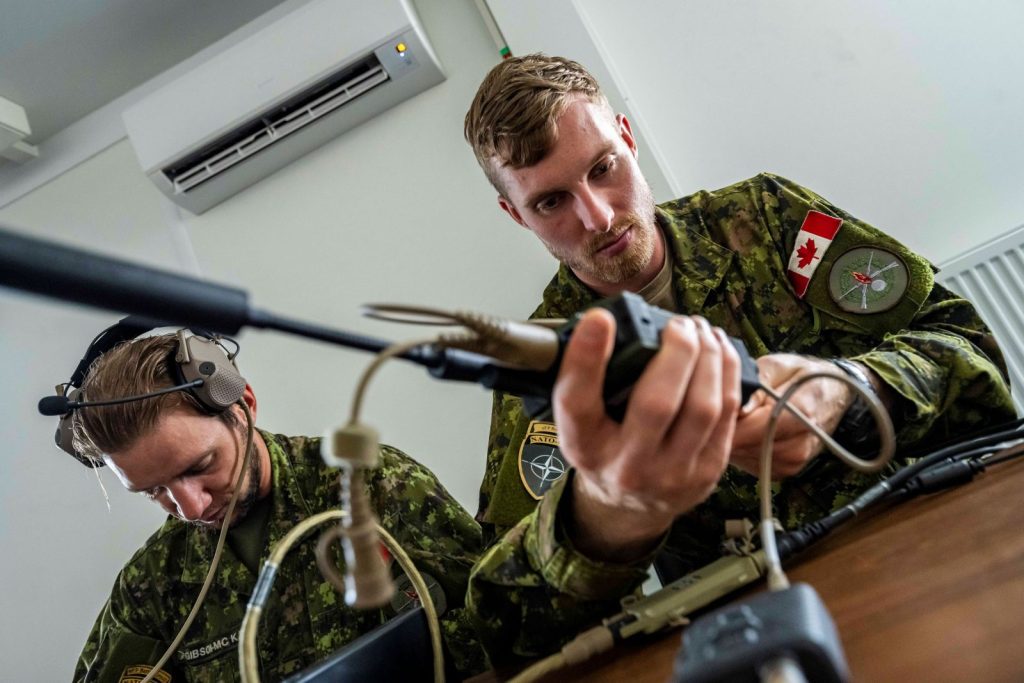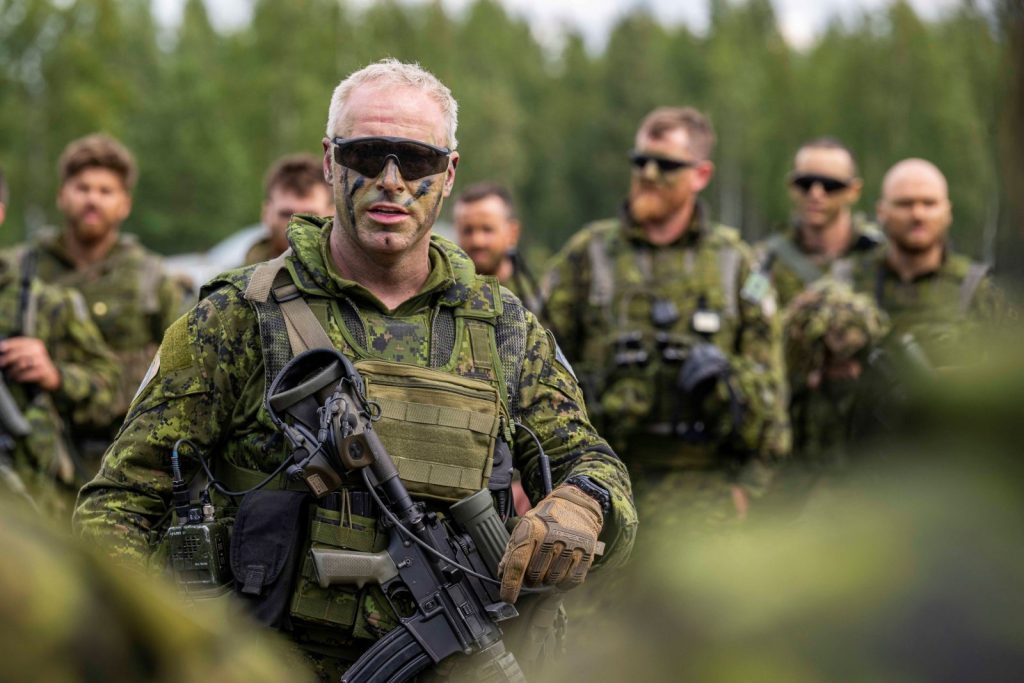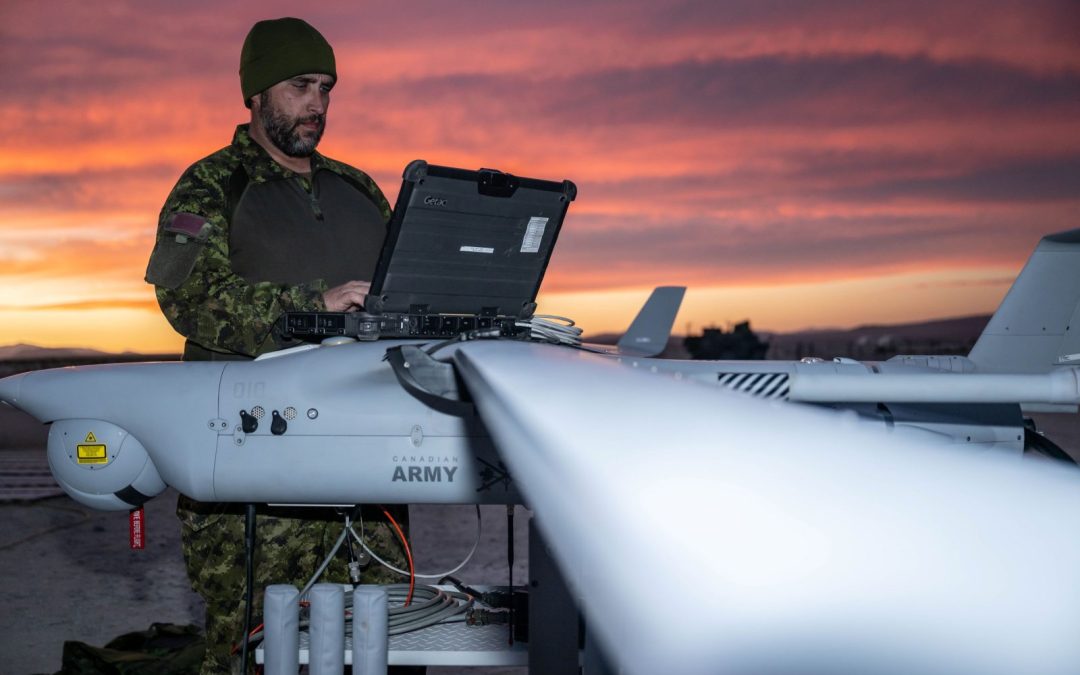In DDACSI, the Army is creating the nexus for a digital force and a continuous and interoperable capability development cycle.
By Chris Thatcher
Over the past 18 months on domestic operations and exercises, the Army has experimented with an interconnected but decentralized brigade command post and trialed a cloud-based tactical network. Both command-and control (C2) systems are now being further refined in Latvia as the Canadian-led multinational battle group begins scaling to the strength of a brigade in the next two years.
“It’s quick flash to bang,” acknowledged Colonel Aaron Luhning, director of the Directorate of Digital and Army Combat Systems Integration (DDACSI).
“We’re trying to circumvent that step where we trial something, find success, then go back to figure out all the training packages and how to institutionalize it. Now, when we have it, we are pushing it directly into theatre. The Army commander sees Latvia as our battle lab to introduce, refine, and iterate on innovative capabilities that can have immediate effect.”
If digital transformation is vital ground, then experimentation and faster incorporation of the technological solutions of successful trials are one of the ways the Army is claiming it. And DDACSI is the nexus through which much of that will occur.
Stood up in June 2023, DDACSI is an amalgam of components of the former Directorate Land Command Information (DLCI) and elements dealing with information and knowledge management, data and analytics, and digital product delivery from the Directorate Army Staff. Previously part of DLCI, the Army G6 is now in the operations line of governance under Chief of Staff, Army Operations (COS Ops).
Though not fully formed yet, DDACSI will work closely with the G6, Director Land Command Systems Program Management (DLCSPM), Canadian Army Land Warfare Centre (CALWC), Defence Research and Development Canada (DRDC), and Director Land Requirements (DLR) as part of an integrated product team for the full cycle of capability development.
It is also tied to the work of Chief Combat Systems Integration (CCSI), an advisor to the Vice Chief of Defence Staff working to achieve pan-domain interoperability.
While Luhning will be a keen observer of how the battle group in Latvia employs and refines the cloud-based tactical network trialed by 12e Régiment blindé du Canada at Exercise Maple Resolve and the dispersed C2 nodal concept initiated by 2 Canadian Mechanized Brigade Group Headquarters and Signal Squadron, the in-theatre delivery of both is the purview of COS Ops.
Instead, DDACSI’s focus is on the next bound, and how the lessons gathered from Latvia and other theatres can inform further iterations of those technologies and the Army’s eventual cloud-based digital backbone.
“We’re the middle orchestration piece,” he said, “collaborating with both current operations and force development organizations to receive feedback on the current products in use and combine them with an understanding of the technology that is coming to set development priorities for DLCSPM and others to evolve existing or build new products for the Army.”

Members of the eFP Battle Group in Latvia with the new Integrated Soldier System Gen 2 equipment in August 2023. Photo: Cpl Lynette Ai Dang
Before Luhning can do any of that, however, he first must build DDACSI.
At present, the organization has more ambition than horsepower, he acknowledged. The current workforce is about 24 personnel, with a large portion drawn from DAS’s former analytics support centre, who now staff a Digital Product Delivery Centre providing software and platform engineering.
Since June, DDACSI has expanded its application development capability and implemented a DevSecOps framework to accelerate and decentralize digital product development, automating integration and delivery, and incorporating security into a continuous cycle of product improvement.
Its applications at this point have a more corporate than operational feel, although the two are intertwined, as DDACSI works on digitalizing and streamlining processes to make soldiers’ lives easier.
“Our [output] is limited, but it is developing,” Luhning said. “One of our immediate objectives is to get the foundational aspects of a directorate in place to be able to support all of this.”
That includes strengthening human resources capacity and contracting capability to bring in the necessary personnel. But it also involves the rollout of an innovation application to serve as a focal point and platform for ideas from across the Army.
“There are tonnes of smart people everywhere, and if you give Army people who can code a problem, they’ll produce a solution within their means, especially if one is not provided to them,” he noted. “That is great bottom-up innovation, and we want to promote that.”
The innovation module is part of the Army App and is built using the Army’s cloud environment provided through the Joint Defence Cloud Program at the Department of National Defence. It will eventually allow access to defence industry to create what he called “the full integrated product team.” DDACSI recently confirmed a digital governance board that will help determine how proposals surfaced by the app are scaled and resourced.
Early digitalization efforts developed by the Digital Product Delivery Centre include an approval process for Honorary Colonel appointments, a task that typical took months and is now completed in hours; a post-deployment checklist that used to be paper-based and required a lot of in-person signatures; and a mentorship app to facilitate connections and track progress between interested mentors and mentees.
“Right now, these are quite heavily focused around processes — things people get annoyed with everyday when they have to work with an outdated or analog system,” Luhning noted. But the effect is significant: fewer people spending less time on repetitious tasks, a critical step for an Army struggling with personnel shortages.
While DDACSI’s current focus is solidifying the foundational pieces of the organization and finalizing the network and supporting architecture to allow it to scale submitted products more quickly, it’s also wrestling with the utility of data.
So far, efforts to draw practical data in an automated way from systems of record like the Defence Resource Management Information System or Guardian have been hindered by inadequate secured and managed interfaces.
DDACSI is now working with a cloud service provider to build a data layer architecture that will make that data accessible in an automated and secure way that is optimized for end-users — starting with all the Army’s personnel, equipment, training, sustainment, and financial datasets.
“Data continues to be a struggle,” Luhning acknowledged. “Our legacy systems or extant policies are not proactively changing to enable data access or use in the way modern applications are used to. That is why we are trying to put an Army data layer in place. It will abstract the application/end-user from the work being done to find, ingest, transform and optimize datasets derived from those systems … and then make them available for consumption, whether it’s powering a dashboard or an application.
“Our people will automatically be able to access the data they need through an API (application program interface) end point. That facilitates achievement of the lines of effort in our Digital Strategy that aim to give end-users more agency over their digital toolset and strengthen our relationship with data — foundational components required to accelerate development and adoption of all those innovative ideas that are out there in a more focused way.”
Like GitHub, a platform for developers to manage, share and collaborate on coding projects, DDACSI wants a portal for anyone in the Army to contribute to a product of interest.
“We’ve already had several individuals raise their hand and say, ‘I want to be involved building things into the Army app.’ We can facilitate it through this framework,” he said.

LCol Daniel Vincent, commander of the eFP Battle Group in Latvia, conducts an after-action review during Ex Titan Strike in 2023. Photo: Cpl Lynette Ai Dang
One of the organization’s priorities is ensuring interoperability among the array of digital systems the Army is acquiring as they move through the force development and procurement processes and are then refreshed and sustained over time. The aim is to ensure pan-domain interoperability, maintaining compatibility among Army platforms and integrating and interoperating those with other services in the Canadian Armed Forces (CAF) and allies.
DDACSI is supporting Project Olympus, a long overdue effort to align the multitude of C4ISR activities across the CAF. Led by the Chief of Combat Systems Integration, the goal is to coordinate Canada’s national objectives, involvement, and participation in the various activities.
The project has the potential to be a high value activity to the Army’s C4ISR/ interoperability program in terms of utilizing scarce resources to produce clear interoperability outcomes for pan-domain areas such as C2, advanced sensing, and target identification.
“Collectively, we are trying to define what frameworks and standards need to be implemented so everybody can plug in and get that coveted zero-day interoperability,” Luhning explained. “CCSI’s efforts with Project Olympus are looking at all our experimentation and making sure things are lined up; which standards and frameworks we are going to implement at all levels. Up to this point, individual service priorities or varying agreements define which frameworks and standards to implement. This initiative will bring more coherence to that space so we can synchronize our efforts.”
With what it’s calling the Capability Development Common Operating Picture (CADCOP), COS Army Strategy expects to have an AI-enabled dashboard-like view of the entire force development cycle for every capability and technology — a means to discover their interdependencies and understand the effects of various decisions.
DDACSI is facilitating that development effort and planning future integration with the Army App platform “so we can track and manage the totality of the Army’s digital and force development portfolio,” he said.
As for digital development ideas from the battle group in Latvia, DDACSI is still working on a structure to encourage feedback as commanders and soldiers field-test different means of C2.
“We are trying to figure out the best way to gather those ideas coming out of theatre and prioritize them,” Luhning said. But if the idea is not classified, the app will soon be open for input.

